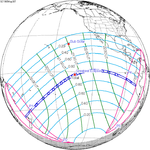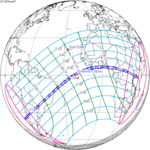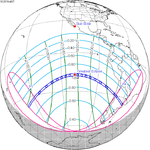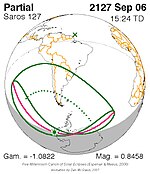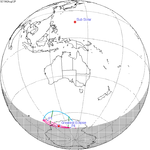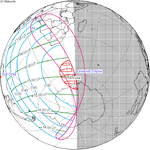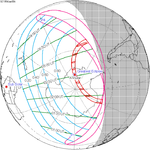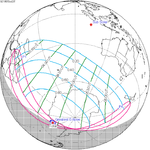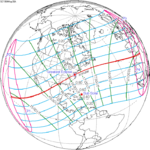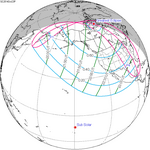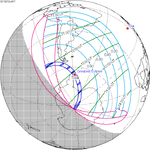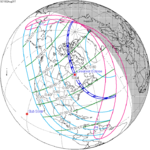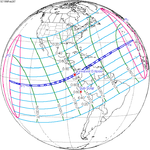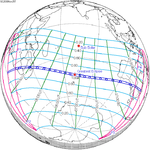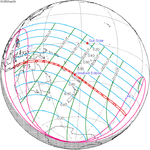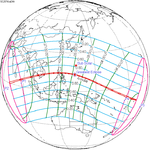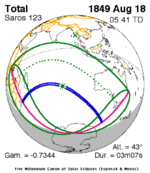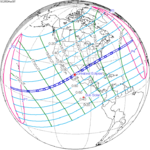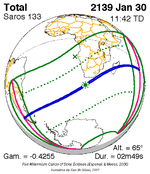|
Solar eclipse of May 30, 1965
A total solar eclipse occurred at the Moon's ascending node of orbit between Sunday, May 30 and Monday, May 31, 1965,[1] with a magnitude of 1.0544. A solar eclipse occurs when the Moon passes between Earth and the Sun, thereby totally or partly obscuring the image of the Sun for a viewer on Earth. A total solar eclipse occurs when the Moon's apparent diameter is larger than the Sun's, blocking all direct sunlight, turning day into darkness. Totality occurs in a narrow path across Earth's surface, with the partial solar eclipse visible over a surrounding region thousands of kilometres wide. Occurring about 1.9 days before perigee (on June 1, 1965, at 19:20 UTC), the Moon's apparent diameter was larger.[2] As most of the eclipse's path was over open ocean, a prolonged observation was made by a jet transport; flying parallel to the path of the eclipse at 587 mph (945 km/h), this gave scientists what was at the time the "longest probe in man's history into the conditions of a solar eclipse", for nearly ten minutes. The expedition involved scientists from NASA, Belgium, Italy, the Netherlands, and Switzerland; in total, 30 researchers and 13 separate research projects were represented on the plane. [3] [4] [5] The plane, operated by NASA, took off from Hilo, Hawaii, and met up with the path of the eclipse approximately 1,000 mi (1,600 km) south of there.[6] While mostly invisible from land, some ground-based observers in an 85-mile-wide strip of northern New Zealand were able to clearly view the event.[6] Totality was visible from northwestern Northland Region in New Zealand on May 31 (Monday), and Manuae in Cook Islands, Manuae and Motu One in French Polynesia, and Peru on May 30 (Sunday). A partial eclipse was visible for parts of Oceania, Mexico, Central America, the Caribbean, and western South America. ObservationsNew Zealand, Australia, the United Kingdom, the United States, Germany, Japan and the Soviet Union sent observation teams to Manuae, Cook Islands to observe the total eclipse. The New Zealand government deployed ships to transport passengers from Rarotonga, the island where the national capital Avarua is located, to Manuae. The atoll has a total area of 1,524 hectares, and only a few copra workers lived there permanently. During the totality, there were 85 scientists as well as their assistants on the atoll. The sun was covered by clouds during the eclipse and observations were not successful.[7] In the northern part of New Zealand's North Island, the total eclipse occurred shortly after sunrise on May 31 local time. Although there were some clouds in the sky on the previous evening, the eclipse was seen successfully. In addition, scientists also launched rockets to obtain observation data from high altitude.[8] Eclipse detailsShown below are two tables displaying details about this particular solar eclipse. The first table outlines times at which the moon's penumbra or umbra attains the specific parameter, and the second table describes various other parameters pertaining to this eclipse.[9]
Eclipse seasonThis eclipse is part of an eclipse season, a period, roughly every six months, when eclipses occur. Only two (or occasionally three) eclipse seasons occur each year, and each season lasts about 35 days and repeats just short of six months (173 days) later; thus two full eclipse seasons always occur each year. Either two or three eclipses happen each eclipse season. In the sequence below, each eclipse is separated by a fortnight.
Related eclipsesEclipses in 1965
Metonic
Tzolkinex
Half-Saros
Tritos
Solar Saros 127
Inex
Triad
Solar eclipses of 1964–1967This eclipse is a member of a semester series. An eclipse in a semester series of solar eclipses repeats approximately every 177 days and 4 hours (a semester) at alternating nodes of the Moon's orbit.[10] The partial solar eclipses on January 14, 1964 and July 9, 1964 occur in the previous lunar year eclipse set.
Saros 127This eclipse is a part of Saros series 127, repeating every 18 years, 11 days, and containing 82 events. The series started with a partial solar eclipse on October 10, 991 AD. It contains total eclipses from May 14, 1352 through August 15, 2091. There are no annular or hybrid eclipses in this set. The series ends at member 82 as a partial eclipse on March 21, 2452. Its eclipses are tabulated in three columns; every third eclipse in the same column is one exeligmos apart, so they all cast shadows over approximately the same parts of the Earth. The longest duration of totality was produced by member 31 at 5 minutes, 40 seconds on August 30, 1532. All eclipses in this series occur at the Moon’s ascending node of orbit.[11]
Metonic seriesThe metonic series repeats eclipses every 19 years (6939.69 days), lasting about 5 cycles. Eclipses occur in nearly the same calendar date. In addition, the octon subseries repeats 1/5 of that or every 3.8 years (1387.94 days). All eclipses in this table occur at the Moon's ascending node.
Tritos seriesThis eclipse is a part of a tritos cycle, repeating at alternating nodes every 135 synodic months (≈ 3986.63 days, or 11 years minus 1 month). Their appearance and longitude are irregular due to a lack of synchronization with the anomalistic month (period of perigee), but groupings of 3 tritos cycles (≈ 33 years minus 3 months) come close (≈ 434.044 anomalistic months), so eclipses are similar in these groupings.
Inex seriesThis eclipse is a part of the long period inex cycle, repeating at alternating nodes, every 358 synodic months (≈ 10,571.95 days, or 29 years minus 20 days). Their appearance and longitude are irregular due to a lack of synchronization with the anomalistic month (period of perigee). However, groupings of 3 inex cycles (≈ 87 years minus 2 months) comes close (≈ 1,151.02 anomalistic months), so eclipses are similar in these groupings.
References
External links
|
|||||||||||||||||||||||||||||||||||||||||||||||||||||||||||||||||||||||||||||||||||||||||||||||||||||||||||||||||||||||||||||||||||||||||||||||||||||||||||||||||||||||||||||||||||||||||||||||||||||||||||||||||||||||||||||||||||||||||||||||||||||||||||||||||||||||||||||||||||||||||||||||||||||||||||||
Portal di Ensiklopedia Dunia





